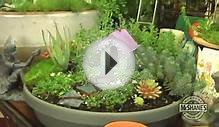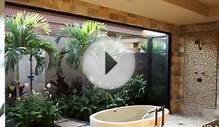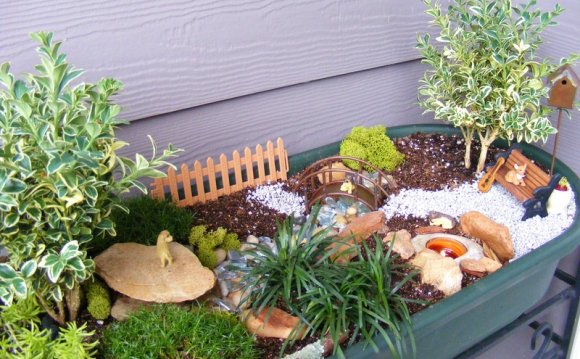
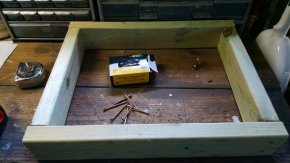 Building vertical gardens or “live walls” are all the rage. You’ve seen these on Pinterest and Better Homes & Gardens magazine, but have you actually seen one of these in real life? These living walls (also called living pictures) are an exciting way to decorate with plants indoors or outdoors, especially when you’re short on space. If you’re looking for a fun weekend gardening project, check out this tutorial on constructing your own vertical succulent garden with a custom hanging planter.
Building vertical gardens or “live walls” are all the rage. You’ve seen these on Pinterest and Better Homes & Gardens magazine, but have you actually seen one of these in real life? These living walls (also called living pictures) are an exciting way to decorate with plants indoors or outdoors, especially when you’re short on space. If you’re looking for a fun weekend gardening project, check out this tutorial on constructing your own vertical succulent garden with a custom hanging planter.
Step 1: Get Your Succulent Plants & Supplies
Supplies and tools needed are:
- 2×4’s (best to get treated wood)
- Galvanized hardware cloth
- Galvanized nails or screws
- Staple gun / staples
- A drill
- A hammer
- Wire cutters
- Gloves
- Garden / landscape fabric
- A miter saw
- Paint / paintbrush (optional)
- Scrap wood, reclaimed wood or an old picture frame (optional)
- Cactus Potting Soil (see below for mixing your own)
- Various Succulent Plants
- Steel hooks with brackets for hanging
Succulents are great plants for this project because they are beautiful, low maintenance and need very little water. They are also easy to propagate, which saves you from having to buy a jillion plants. If you plan to propagate your succulents, you will want to start that process a few days in advance, so the cuttings have time to callous over.
We bought our succulents from the Olbrich Botanical Gardens annual plant sale and from Jung’s here in Madison. Whenever possible, we like to support local nurseries and growers.
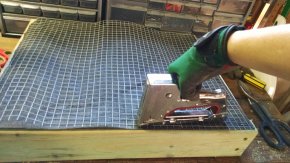 Step 2: Building the Vertical Planting Box
Step 2: Building the Vertical Planting Box
Building the box is the most time consuming part of the process. You can also buy premade hanging planting boxes, but around here, we always like to do it ourselves! Smaller boxes are a bit easier to make and will weigh less, so that might be better for indoor hanging gardens.
Measure the 2×4’s carefully. The beauty of making your own wall planting box is that you can make any size you want that fits your space. We just used scrap pieces of lumber we had lying around for the inner frame. Make sure you use treated lumber so it doesn’t rot after time.
Put at least two large screws in each side. You may also want to reinforce the joints with brackets.
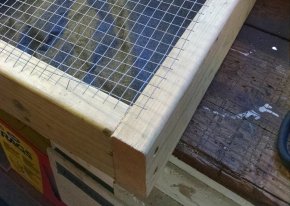
For the back panel, measure and cut the hardware cloth and landscape fabric about a 1/4 inch inside the frame to leave room for stapling. In this case, we secured the corners of the landscape cloth first to make sure it was pulled tight and then stapled both the landscape fabric and the hardware cloth around the edges. It’s a good idea to wear gloves when you are cutting the hardware cloth as there will be some sharp edges. (Why it is called “cloth” I couldn’t tell you as there is not a lot about this wire that is cloth-like.)
For the front side of the inner frame, measure and cut another piece of hardware cloth and secure it with staples.
For a little extra pizzazz, we decided to paint our inner frame lime green. One can never have too much lime green in my opinion, especially on the deck, which is where this vertical succulent garden will live. It’s best to do the painting before securing the outer frame, and you can let it dry while you work on the outer frame construction.
Step 3: Making The Outer Frame
You can buy a pre-made frame to put on top of the gardening box, but we made one out of reclaimed wood.
Measure and cut the reclaimed boards to fit together like a picture frame, overlapping the boards slightly. Make sure to remove any staples or old nails that are in the boards before cutting.
You can use glue and brackets to hold the boards together if you want, but we are also going to nail them right into the inner frame. The outside frame is mostly for decoration, so it doesn’t need to be quite as sturdy as the inner frame.
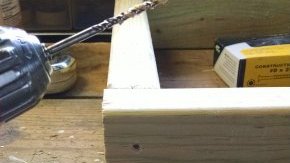
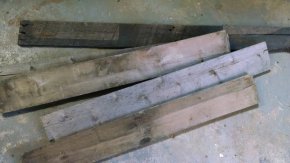
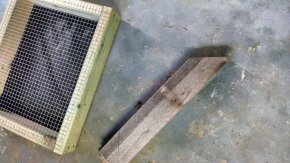
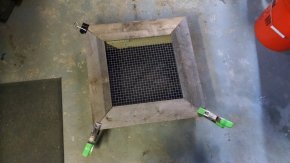
YOU MIGHT ALSO LIKE
